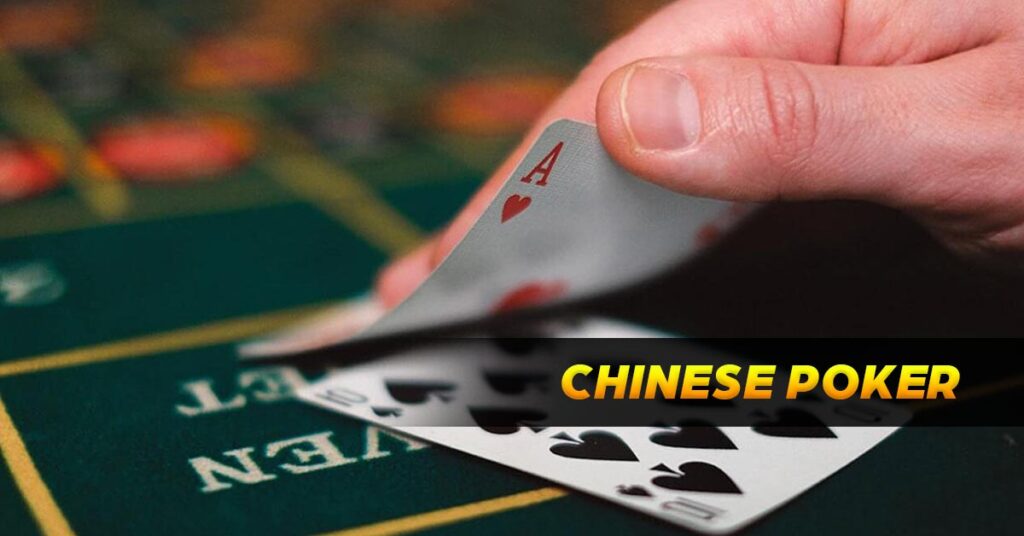Chinese Poker: A Card Game of Strategy and Skill
Chinese Poker, also referred to as Pusoy or Russian Poker, is an intriguing card game with its roots in Asia, now beloved by players worldwide. Distinguished from traditional poker variations like Texas Hold’em or Omaha, Chinese Poker doesn’t involve community cards. Instead, each player receives a fixed number of cards to construct three distinct hands. This distinctive structure and engaging gameplay have made it a cherished choice among both casual players and seasoned gamblers. In this article, we’ll uncover the rules of Chinese Poker and explore key strategies to aid you in mastering this captivating card game of Lodigame.

Chinese Poker: A Comprehensive Guide to Deck, Rankings, and Gameplay

Chinese Poker is a captivating card game typically played with 2 to 4 players, each vying to organize their 13 cards into three distinct hands: the “middle,” the “back,” and the “front.” The ultimate goal is to outdo your opponents in all three-hand categories.
The Deck
Chinese Poker employs a standard 52-card deck, generally devoid of jokers. However, some variations introduce jokers as wild cards, adding an element of unpredictability and strategic depth.
Card Rankings
A firm grasp of card rankings is paramount in Chinese Poker. The card hierarchy aligns with standard poker, where aces reign supreme and twos are at the bottom. The ranking order is as follows:
Ace > King > Queen > Jack > 10 > 9 > 8 > 7 > 6 > 5 > 4 > 3 > 2
Hand Structure: Front, Middle, and Back Hands
Chinese Poker assigns 13 cards to each player, with the mandate to divide them into three separate hands:
- Front Hand: This comprises three cards and must be the weakest of the three hands in poker ranking. It is placed in front of the player with the cards facing downward.
- Middle Hand: Comprising five cards, the Middle Hand is positioned face-down between the Front and Back Hands. It should be stronger than the Front Hand but not as strong as the Back Hand.
- Back Hand: The Back Hand consists of five cards and is the most potent hand among the three. It must possess the highest poker ranking compared to the other two hands.
Dealing and Gameplay Setup
Before diving into the game, players must reach a consensus on betting stakes and rules, including the potential use of jokers and the scoring system.
- Dealing: The dealer meticulously shuffles the deck and deals 13 cards to each player, one card at a time.
- Card Placement: Upon receiving their 13 cards, players discreetly arrange them into Front, Middle, and Back Hands, shielding them from opponents’ prying eyes.
- Showdown: After all players have organized their hands, they simultaneously unveil their cards.
Scoring and Victory
Post-showdown, each player’s hands are pitted against those of their adversaries. Points are allocated based on winning combinations and hand strength. The player with the most formidable Front, Middle, and Back Hands garners points from each opponent for each corresponding hand. If a player bests all three hands against an opponent, they achieve a “scoop” and pocket a bonus.
Special Hands and Bonus Points
Chinese Poker introduces special hands that yield bonus points, infusing excitement into the game. Some common special hands encompass:
- Four-of-a-Kind: Four cards of the same rank in the Back Hand.
- Straight Flush: A sequence of five cards of the same suit in the Back Hand.
- Royalties: Unique combinations like a pair of queens or better in the Front Hand, a full house or better in the Middle Hand, and three-of-a-kind or better in the Back Hand.
Chinese Poker Strategies: Elevate Your Game and Conquer the Table
Chinese Poker transcends mere chance; it’s a game that demands strategic acumen, meticulous planning, and adaptability. If you aspire to improve your chances of triumph and dominate the table, consider integrating the following Chinese Poker strategies into your arsenal:

Analyze Your Opponent’s Hands
Observe your adversaries’ actions and discards during the game to glean insights into their hand compositions. Pay particular attention to the cards they place face-up in their Middle and Back Hands, as this intel can inform your own card placement. The ability to predict your opponents’ potential hands empowers you to adapt your strategy, either by taking calculated risks or adopting a more conservative approach.
Balance Your Front, Middle, and Back Hands
Striking a balance among your three hands is paramount. While a robust Back Hand is crucial for amassing points, neglecting your Front and Middle Hands can spell trouble. Aim to construct well-rounded hands by strategically distributing cards based on their poker rankings. Resist the temptation to craft an excessively strong Back Hand at the expense of your other two hands.
Control the Middle Hand
Recognize the pivotal role of the Middle Hand in Chinese Poker. It serves as a bridge between strength and vulnerability. Utilize your Middle Hand to thwart your opponents’ potential formidable Back Hands while creating opportunities for your Front and Back Hands to excel.
Capitalize on Special Hands and Bonuses
Special hands like Four-of-a-Kind, Straight Flush, and Royalties offer substantial bonus points that can sway the game’s outcome. Keep a keen eye out for chances to form these combinations, particularly in your Back Hand. However, remember that an exclusive focus on special hands shouldn’t eclipse the fundamentals of balanced card placement.
Play Aggressively and Responsibly
Chinese Poker rewards calculated risks. Embrace aggressive moves when you possess a potent hand or spot an opening to disrupt your opponents’ strategies. Exercise caution not to overcommit your Front and Middle Hands prematurely, as this could limit your options for your Back Hand. Striking a harmonious equilibrium between assertiveness and prudent decision-making is pivotal for enduring success.
Adjust Your Strategy Based on Opponents
Each opponent boasts a distinctive playing style and skill level. As your experience burgeons, tailor your strategy to exploit their vulnerabilities and counter their strengths. Against conservative adversaries, consider embracing a more aggressive stance, while confronting aggressive opponents may warrant a more measured approach.
Stay Focused and Composed
Chinese Poker can be mentally taxing, especially during pivotal junctures. Sustaining concentration and eschewing impulsive decisions are indispensable attributes. Maintain a clear, composed demeanor under pressure to render sound strategic choices. Over time, this mental resilience will evolve into a priceless asset in your gameplay.
Benefits of Playing Chinese Poker: Enhancing Mental and Strategic Skills
Participating in a game of Chinese Poker offers more than mere entertainment of online casinos; it cultivates a spectrum of advantages that extend to mental and cognitive capacities. Let’s explore the benefits of engaging in Chinese Poker, particularly in terms of mental and strategic skill development:

Critical Thinking and Decision-Making
Chinese Poker necessitates meticulous card analysis, anticipation of opponents’ moves, and judicious decision-making. Players must evaluate the strengths and weaknesses of each hand, striking a balance between risk and reward while determining optimal card placements. Regular engagement in Chinese Poker hones critical thinking and decision-making skills, which are transferable to daily life, problem-solving scenarios, and other strategic games.
Memory and Concentration
The game relies heavily on memory skills, encompassing the ability to recall cards played by opponents, track discarded cards, and remember one’s own actions. Chinese Poker challenges players to maintain information across multiple rounds and employ it to their advantage. Consistent participation in the game enhances memory retention and bolsters concentration, skills that prove advantageous in academic, professional, and attention-demanding contexts.
Patience and Emotional Control
Chinese Poker, akin to card games in general, experiences fluctuations in luck and outcomes, with instant success not always guaranteed. Players learn to cultivate patience even during trying rounds, fostering emotional control and mental resilience. These acquired skills are invaluable in various real-life situations, such as coping with stress or maintaining composure in high-pressure scenarios.
Risk Assessment and Probabilistic Thinking
Chinese Poker involves evaluating risks, calculating probabilities, and comprehending expected outcomes. Players weigh various factors, including card distributions, potential hands of adversaries, and the likelihood of forming special combinations. Proficiency in probabilistic thinking gleaned from Chinese Poker can translate into enhanced risk assessment in diverse real-world contexts, including financial planning and decision-making under uncertain circumstances.
Strategic Planning and Adaptability
The game calls for creating well-rounded hands and adjusting strategies in response to opponents’ moves. Players must assess evolving situations, formulate adaptable approaches, and tactically react to optimize their gameplay. These skills cultivated in Chinese Poker prove valuable in various competitive settings, be it in games or real-life situations demanding strategic acumen.
FAQs
Conclusion
In conclusion, Chinese Poker is a captivating card game that offers players a unique and strategic gaming experience. With its distinctive hand structure, scoring system, and bonus points for special hands, Chinese Poker challenges players to think critically, adapt to opponents, and cultivate valuable skills that extend beyond the gaming table. Whether you’re a casual player or a seasoned gambler, mastering Chinese Poker can be both intellectually rewarding and highly enjoyable.

















